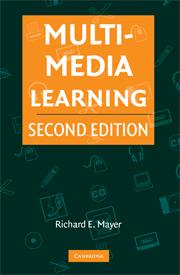Book contents
- Frontmatter
- Contents
- PREFACE
- SECTION I INTRODUCTION TO MULTIMEDIA LEARNING
- SECTION II PRINCIPLES FOR REDUCING EXTRANEOUS PROCESSING IN MULTIMEDIA LEARNING
- SECTION III Principles for Managing Essential Processing in Multimedia Learning
- SECTION IV PRINCIPLES FOR FOSTERING GENERATIVE PROCESSING IN MULTIMEDIA LEARNING
- 12 Multimedia Principle
- 13 Personalization, Voice, and Image Principles
- SECTION V CONCLUSION
- REFERENCES
- AUTHOR INDEX
- SUBJECT INDEX
- References
12 - Multimedia Principle
- Frontmatter
- Contents
- PREFACE
- SECTION I INTRODUCTION TO MULTIMEDIA LEARNING
- SECTION II PRINCIPLES FOR REDUCING EXTRANEOUS PROCESSING IN MULTIMEDIA LEARNING
- SECTION III Principles for Managing Essential Processing in Multimedia Learning
- SECTION IV PRINCIPLES FOR FOSTERING GENERATIVE PROCESSING IN MULTIMEDIA LEARNING
- 12 Multimedia Principle
- 13 Personalization, Voice, and Image Principles
- SECTION V CONCLUSION
- REFERENCES
- AUTHOR INDEX
- SUBJECT INDEX
- References
Summary
Multimedia Principle: People learn better from words and pictures than from words alone.
Example: A multimedia lesson consists of an animation depicting the steps in lightning formation along with concurrent narration describing the steps in lightning formation, whereas a singe-medium lesson consists of narration alone. A multimedia lesson consists of illustrations depicting the steps in lightning formation along with printed text describing the steps, whereas a single-medium lesson consists of text alone.
Theoretical Rationale: When words and pictures are both presented, learners have an opportunity to construct verbal and visual mental models and to build connections between them. When words alone are presented, learners have an opportunity to build a verbal mental model but are less likely to build a visual mental model and make connections between the verbal and visual mental models.
Empirical Rationale: In eleven out of eleven tests, learners who received text and illustrations or narration and animation (multiple-representation group) performed better on transfer tests than did learners who received text alone or narration alone (single-representation group). The median effect size is d = 1.39.
Boundary Conditions: The multimedia principle may apply more strongly to low-knowledge learners than to high-knowledge learners, presumably because low-knowledge learners need guidance in building connections between pictorial and verbal representations.
Information
- Type
- Chapter
- Information
- Multimedia Learning , pp. 223 - 241Publisher: Cambridge University PressPrint publication year: 2009
References
Accessibility standard: Unknown
Why this information is here
This section outlines the accessibility features of this content - including support for screen readers, full keyboard navigation and high-contrast display options. This may not be relevant for you.Accessibility Information
- 4
- Cited by
